It is simple. My email is nels@stylites.net. Please direct queries regarding use of pictures or content, Senli and Frye tailoring, or purchasing the Dowdy fourhundred leather bags or any other subjects to this email address. See the “About Nels Frye” section for additional information. Thank you very much.
Tag: China Fashion News and Analysis ä¸å›½æ—¶è£…æ–°é—»åŠè¡Œä¸šåˆ†æž
News about China’s fashion market and industry, including reports on factory visits, events, etc.
2009: What will be new on the streets of Beijing?
Following are some of my predications regarding fashion on the streets of Beijing and other cities in China in 2009. I’m not an expert on women’s fashion, so please forgive the emphasis on males.
1. The gap is closing: Beijing is soon only three months behind London and Tokyo in adopting new styles. Slim tartan shirts, skinny jeans must already be old in those cities. What is next? All of these styles trickle down to second-tier cities in the space of a year.
2. Trouser waists: Higher waists for men’s and women’s trousers, but the fuller leg doesn’t really catch on and tapering remains the mainstream choice.
3. Ankles: The skinny leg with stacking around the ankle becomes the norm for fashionable people in wealthy second-tier cities.
4. Ties: Really skinny ties (1-2.5 inches) become popular for the late adopters but reach a saturation point for hip kids. Other colors beyond the basics become more popular as do the knit ties that have been sweeping Korea and Japan. Among young business men around the world, demand for a happy medium width of around 3 to 3.25 inches is agreed upon and becomes the mainstream. Wide ties of 3.75 to 4 inches remain unfashionable, but are still the most common type of tie in China and abroad. In mainstream Chinese society, ties are still a necessity rather than a joy to wear. Will one of the producers in Shengzhou improve quality to compete with Como, thus driving the Italians further into a corner in terms of their remaining competitive advantages (better color, ability to do small orders, taste, style and design)?
5. More sophistication for 2009, combined with frustration at the lack of quality in simple cuts on the market; more brands rise to trye to meet this demand. Fewer loud labels, lace, and pleather as people go for better quality.
In general, my assessment is that Beijing has made incredible progress in terms of style and is pretty close to being on par with all cities but New York, London, Milan, and Paris. There are so many more possible predictions than this. What do you think?
Mannequins Designed by Machine
Ever notice that most mannequins look a bit like Barbie or He-man? A Janice Wang has come up with mannequins scans of bodies of the target consumers. Her company will offer a mix of products and service. In addition to the more accurate physiques of her models, she will tell clients exactly what shapes and sizes are needed to match the demographics where the clothing will be selling. This could be yet another advantage for ready-to-wear clothing over tailor-made.
From Bibs to Berluti
Do keep in mind the monotony of the street scene in China just thirty years ago. This AFP piece reminds us that not only fashion has returned. Shanghai and Beijing were more or less in black in white at the start of Reform and Opening.
There are some interesting tidbits about the fashion then. In 1978, cotton was competing with grain for agricultural land. For me, a frustrating result was perfection of polyester technology. The scarcity of cotton meant, a dress shirt cost half a person’s annual rations. An entire outfit was often worth the entire family’s yearly allowance of ration coupons. Since entire shirts were such an extravagance, men would wear just the collar, a kind of bib that would be visible over a jacket or sweater.
Now Shanghai and Beijing are filled with shopping addicts who have years worth of outfits in their wardrobes. Men can buy RMB 20,000 Berlutis, shoes so lovely that a shirt is barely necessary.
Still, sometimes it seems the majority of men are still in black and white. Fellows appearing on Stylites notwithstanding, men have made less of a shocking jump than women. Though it may not be a uniform, the majority of men particularly in tier two or three cities seem to be dressed quite quite nearly identically.
A Lack of Artisans
The number of skilled craftspeople is fast declining in the UK, according to this piece from the Independent. Most of the artisans capable of doing advanced handwork needed for haute couture in companies like Burberry Prorsum and Mulberry are over fifty. American Shoemaker Allen Edmonds faces the same problems, says the New York Times. They will either have to hire immigrants or send the work over to China, which they have always worried would mean compromising on quality, since the emphasis is on mass production here.
Interestingly enough, here in Beijing at Senli and Frye, we could be facing the same problem in the future. The small group of artisans that crafts our suits are all over forty. This reflects both China’s status as a low-cost manufacturer of assembly-line type goods and the career aspirations of younger craftspeople. Of course there are young tailors in China but they tend to either work for a big company or start their own business. At the same time, most young people in fields related to fashion prefer the lofty road of design to being an artisan. As I search for companies here in China that could produce a shoe line for us, I am constantly reminded that there are only big factories. Smaller specialty or high-end shoe crafters like Allen Edmonds are hard to fine. I will be learning more about this in the future.
Autumn Scarves: Short Sleeves, Plaids, and Leopard Print
Every May and June, fashion columnists pour out statements like “this summer, long, lightweight scarves in silk or linen are a must-haves” followed by a list of justifications like avoiding sun-burns and a roster of Hollywood actresses adopting the style. This summer saw even more New Yorkers pairing scarves with tank tops and tees. New York Times photographer Bill Cunningham has amusing reflections on this trend. The blog Stuff White People Like, recently made into a guidebook, also comments on this seasonless love of scarves, apparently a noted characteristic of the author’s hipster/borgeousie who seem similar to the bobos in Bobos in Paradise.
In Beijing, the summer is too ghastly to justify donning a scarf even for the very most affected fashionistas. Only in Autumn did the scarf paired with summery garments emerge across the city. Over the last couple of weeks, almost every young person has been wearing a scarf, usually without a jacket. In daytime, Autumn temperatures can be hot, while at night the wind blows hard and it is chilly. I comfortably wear a tee shirt in the day and then add a sweater and tweed coat at night.
These photos of pedestrians around the city celebrate the warm part of Autumn, which just passed.
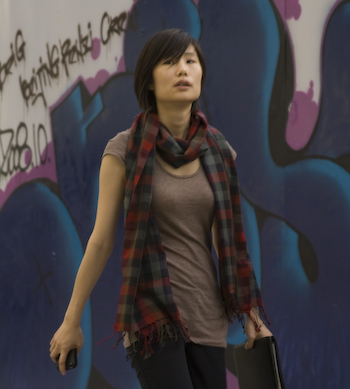
1. If temperatures do drop dramatically, keeping the neck warm is essential. Presumably, no one ever got a cold from exposing their arms.
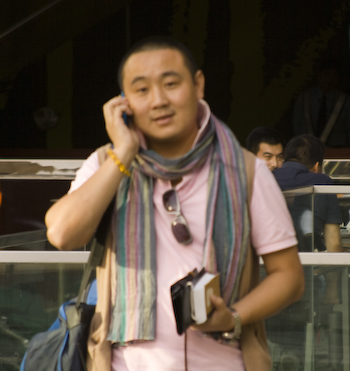
2. This fairly heavy scarf could be pulled tight at night when gales blow. This fellow looks to lack a single pretentious bone in his body, so the scarf cannot be to show-off.
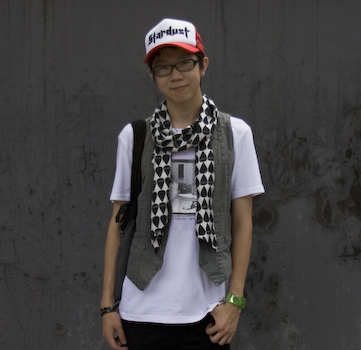
3. Perhaps scarves make somewhat more sense with a vest.
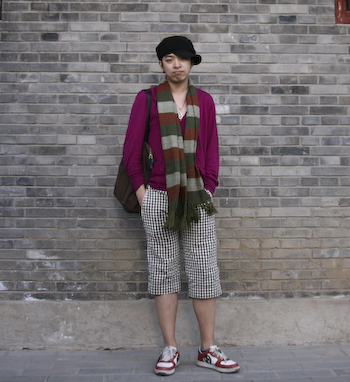
4. A low-neck sweater, wool scarf and shorts? English schoolboys exposed their legs in the depths of winter. However, this fellow has clearly become too Westernized, because in China legs and feet are considered to be the most important areas to keep warm.
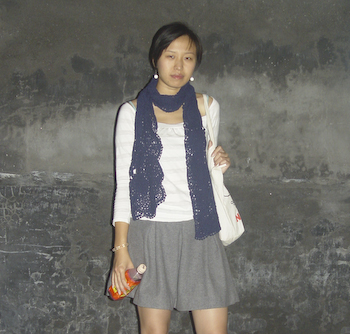
5. Though more attractive, this look is just as oblivious to the dictates of Chinese traditional medicine. Her mother would find wearing a scarf and a short skirt with no stockings to be an entirely nonsensical style.
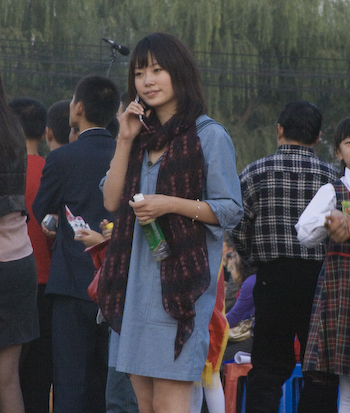
6. This voluminous one could easily cover the shoulders and perhaps even head if things got especially chilly.
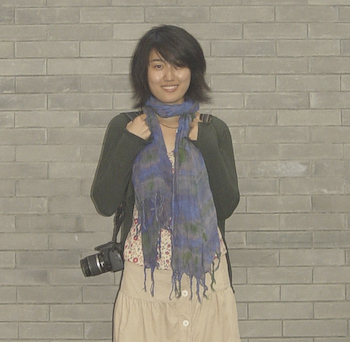
7. This thinner scarf makes a bit more sense as a mainly decorative item.
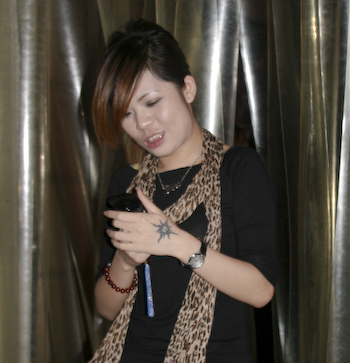
8. Drape a bit of cat around the neck to keep toasty while dancing at Mix. It matches perfectly with her hair.
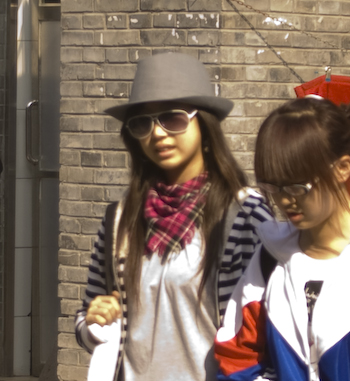
9. But the most common type of scarf has been plaid and made of thin acryllic. Every second girl under the age of thirty has been sporting a variety of lengths of this type of scarf.
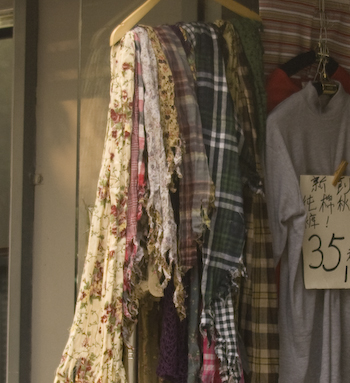
10. It’s not hard to see where they come from: bunches like this hang at every corner.
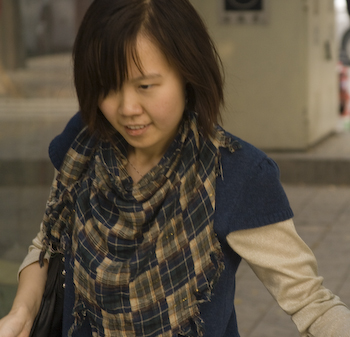
11. This is probably the most common look.
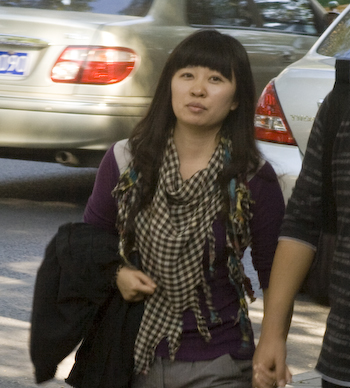
12. And other shapes abound as well. Now I am anxious to see what the scarf styles will be for the seasons in which one really does need the warmth.
WSJ Notes the Waistcoat Crisis in Beijing
WSJ’s very informative and useful China Journal mentioned Stylites’ waistcoat post in their blogs of the day post.
Reaching Stylites
Just a reminder that until October 13 I am not in Beijing and cannot return phone calls in a timely fashion. Regarding Senli and Frye, tailoring, please send emails to tailoring@stylites.net. Other questions related to Stylites can be sent to nels@stylites.net. Thanks a lot.
Tedious Trend Three: Skulls
Calling this trend “tedious” is far too glib, considering the long history of the skull in art, jewelery and fashion. As this fun Esquire piece contends, the current omnipresence of skulls matches our global society’s unabashed embrace of wealth and materialism with its ephemeralness. The skull is probably even more fitting for this moment in China’s history and quite an appropriate symbol to mention on a website that celebrates a new blossoming of individualism and vanity. The skull has, often, represented the meaninglessness of these eternal human pursuits. There is not enough time to consider whether the skull might have any relation to this day, on which the Chinese people celebrate standing up for fifty-nine years, ever since the Great Helmsman declared the birth of the People’s Republic. I did want to wish everyone a happy October first.
Anyway, here are just a few pics, of hundreds I could have chosen, to show that skulls in all forms are just as common in China.
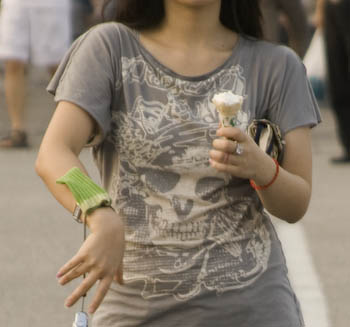
This one is a little bit pirate-like. This was right next to the bird’s nest.

Here we have a creative skull that seems to have an almost Central American influence. The wearer works in the new Mac store.
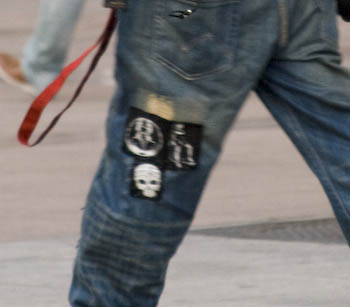
Here is a skull on the leg of a skater.

And a skull with paper clips.
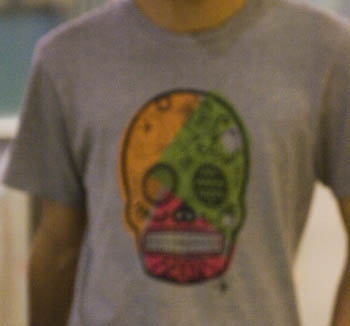
This one looks as if illnesses have haunted it well into the grave.
This post reveals my ignorance more than anything else. More research clearly needs to be done on the subject of skulls in Chinese culture. When young people in China wear shirts with skulls is it rebellious (like it was previously in the West) or is more fashionable (like it is now)? Clearly it has to be associated with death. Some might respond that they are just wearing shirts that they find amusing, but it cannot be that simple. There have been decorative skulls made from jade dug up at sites in China, suggesting ritual importance for the symbol.
Tedious Trend Two: Waistcoats and their Ilk
Too many photos, too little time…This post should have appeared a while back, but life has been filled with travel and tasks demanding completion. But now we can finally turn to this vital subject…tedious trends in Beijing.
Notice the number of waistcoatish things on the street over the last five months? It was some kind of virus. From April to September, the number of men and women sporting them grew exponentially, by the day, and so did the types of waistcoats. Starting out, it was the usual trendy kids, but pretty soon peasants, cleaning ladies, mothers and engineering students had caught on. The trend goes back to the runway, but in New York and presumably Paris and London, it has not gained the sort of traction that it has in Beijing. On my last trip to NYC, I only saw a few ultra-Eurotrashy trophy wives, tramps, and sidewalk hawkers sporting casual waistcoaty things. Maybe fall will bring more, but in Beijing this summer, it was everyone…
1. This attractive young lady might be described as the “typical” waistcoat wearer. She is packing just as many current trends into her outfit as she has accessories and articles of clothing. The big LV bag – Asia’s emblem of class and sophistication – the camo print belt, the stacked, skinny jeans, and of course the casual waistcoat – place this pretty thing firmly in this moment. The color and soft construction of the well-fitting waistcoat put her look well above the pics you are about to witness though. The outfit may be tedious and prettiness is not enough to win a devoted entry on Stylites, but the hand obscuring the face is intriguing. One cannot deny this fact.
2. This rather confusing pleather version has much going on. Wearing waistcoats and plain tees must be breaking some kind of sartorial rule, but I suppose bikers wear leather ones all the time. This has the lapels from a more formal waistcoat one might wear under a morning coat to a wedding (though I would choose double-breasted and maybe shawl lapels). It also has metal buttons and some kind of bow activity on the right. One thinks that the expression and elaborate earring succeed in dressing down the ambiguous waistcoat, though the nametag suggests that the pieces might have a vague functionality.
3. As if pleather was not enough, some more esoteric chemicals had to be introduced. Perhaps this one is made from melamine? Like the first girl, this more aggressive female chose to wear a tee with a face under her skimpy waistcoat. Note the chain closure. The question one might ask here is whether this thirty plus women is of a lower economic level or merely older, tougher, and more oblivious. She might be from the Northeast, a region ever associated with tough broads.
4. Skimpy sparkling waistcoats were a very serious sub-trend. This young lady was wandering around glittering Sanlitun Village with her beau for the better part of an afternoon. I know because I was wandering too. It appeared from the absence of shopping bags that “American Express” was merely on her chest, and not in her pocket. Or maybe she meant to make some odd statement about the value of certain parts now that milk formula must be imported?
5. Materials other than polyeruthene and silicone monomer can also be used to make tasteful and stylish waistcoats. Denim was generally (or thankfully?) less common. Which demographic might be associated with denim waistcoats in the West? I haven’t explored Middle America, so I genuinely don’t know. Is it the same people who wear cut-off denim shorts?
6. One must remember that, in the final analysis, waistcoats are about exhibiting one’s fine taste. An ordinary Zhou would just wear the tee-shirt; adding a waistcoat shows taste and flair. Over the last couple years, I have noticed pursuit of taste become much more widespread, everywhere. We used to pursue “cool” and “rad” and now it is “taste” and “style” (or did I just grow up?). Blatant indicators of status are often relegated to consumers less accustomed to life in the big city such as this hairdresser from Henan. The bag is real and he bought it abroad. The waistcoat has a light blue check. In fact, waistcoats of more traditional colors, almost always matching the fabric of the suit, only become de rigeur in the nineteenth century. Before that, it was quite normal to wear them in colors or patterns that contrasted with the rest of an outfit.
7. And here on this gender neutral fashionista striding down Wangfujing is another waistcoat with lapels, this time with black piping. This ensemble seems more interesting with blacks working together in contrast to the gray and the orange mullet-type hairdo topping it off. Most waistcoats were black but light gray and white were other major colors. Considering the playful and casual way in which the garments are worn, it was surprising that there weren’t more patterns and bright colors. It would be nice to see more tartan or at least houndstooth in the waistcoats for next summer.
8. Like many above, this might be more of a “vest thingy” than a piece of attire than can be properly termed a “waistcoat” but it does allude to formal dress. These lower buttoning waistcoats demand a shirt with ruffles. I would love to see young ladies in Beijing clad in some casual version of male evening wear – if it were done properly and by the right person. That is actually kind of hard to imagine. The make up and hair would have to be done right as would the personality and background.
9. Here is a low buttoning one paired with pea coat and tee-shirt. I think he is on the right track but the toughness of the tee and the militaristic coat don’t exactly jibe with a waistcoat that seems delicate and could almost be out of evening wear. I’m trying to think of what kind of waistcoat would be better in this case.
10. In the low button stance category, there were also double-breasted examples like this, always worn undone by women. I’m fond of the idea of double-breasted waistcoats buttoned under a suit and with lapels of some kind. I haven’t gotten around to making a suit with this though.
11. In addition to the low buttoning coats, there are the single-button ones like this that seem to hit right at the natural waist. Could this work for a man if it were made a little longer, but keeping the single button?
12. Here is another breed of waistcoat for men on the move. These are the practical fellows that get things done and need a cover that can stand a beating from a hard day’s work and the elements, a perpetual nuisance in Beijing even if the government controls when they appear. These pieces are made of rugged materials and often have pockets and other details that speak to their utilitarian nature.
13. These are for hip guys who know where they are going, generally either to design something on a screen or sell a pair of special edition converses or an ipod.
14. The rugged type of waistcoat also fits college students on safaris through this miasma of a city where a sandstorm or black Audi can hit at any moment.
15. But when it comes to a man for whom wearing a modernized waistcoat really does seem appropriate, this magician must be the one. The waistcoat alludes to both performance and service. A costumey example like this seems just right for doing card tricks at a birthday party.
16. In the end, waistcoats might be best suited for the tough life of a mother. She can go to battle, embracing all of her responsibilities, comfortable in the knowledge that she is properly armored.
It seems there are no photos of the backs of these waistcoats. Too bad. In general, the women’s featured either buckles or a knot and an open back. The men’s tended to have an unadorned back – just fabric with no fastening devices.
Tedious Trends from Summer and the Olympics, Part One: Kappa and Italy
Though I tend to dislike big trends, sometimes I can’t help but noticing them when their omnipresence starts to make it seem like I will never find anyone interesting to photograph. So, I have decided to do something a little different with a series on the most tedious trends of the last few weeks. To start, at this Olympics, everyone was wearing Kappa or something related to Italy.
I have a friend who is a designer at Kappa and their two woman logo is cool, but I’m against any type of free advertising and brand that dominates the landscape without a subtle touch.
Kappa must be the most successful company when it comes to plastering China with its logo.
Sure, for a sportswear brand it does seem more provocative than Adidas or Nike.
I hope the Italian government is subsidizing this. Italian brands can probably get away with displays like this more than American ones.
Apparently Chinese audiences were comparatively supportive of Italian athletes. It’s not surprising.
Even names of towns make it onto the apparel. This must help with encouraging tourism from China.
Even some foreign kids are getting in on it.
We like to complain about Chinese nationalism, but the Chinese flags at the Olympics were mostly stickers. The Italian flags are permanently on the clothes.
Now they just need to get “Italia” onto the famous manpurses and they can plaster the Middle Kingdom.
American Apparel to open in Sanlitun
The other day, I helped carry boxes at the new American Apparel (AA) at the Sanlitun Village. The new shop is scheduled to open before the Olympics along with another branch at the World Trade Center. These will be the first two AAs in China.
As with many middle-market foreign brands operating in China, their plan is for the brand to be slightly more upscale than it is in the US. This will be accomplished mainly through the locations and appearance of the shops.
The products will be exactly the same ones that sell in the US market. I don’t want to dwell on the funny contradiction of having “made in USA” clothing selling in China. Several media stories explore this and discuss AA store openings in China. Hopefully AA will help reduce the trade defecit. AA believes the origin of their products will have a certain caché with young urban people here in China.
Prices will be slightly above the US, but this is only because of import taxes and shipping costs and not because of an increase in profit margins. At first, it struck me as odd that foreign clothing brands sell their products at prices higher than those in the West in a country where the average wages are, very roughly, one-fifteenth of Western levels. The Western levels of pricing for fashion products serve to remind us of the income disparity here and the fact that what we often refer to as “the middle class†is actually an elite in comparison to the rest of the population.
Prices will be slightly above the US, but this is only because of import taxes and shipping costs and not because of an increase in profit margins. At first, it struck me as odd that foreign clothing brands sell their products at prices higher than those in the West in a country where the average wages are, very roughly, one-fifteenth of Western levels. The Western levels of pricing for fashion products serve to remind us of the income disparity here and the fact that what we often refer to as “the middle class†is actually an elite in comparison to the rest of the population. Urban white collars working for foreign firms and the children of government officials and entrepreneurs will have no trouble affording AA or luxury brands. But it is critical that the right techniques are used to attract the people who can pay. Prices so out of sync with the average salary are one reason why foreign fashion brands all must make some effort to pitch their brand as high-end.
The prices for the raglan tops, polo-type knit shirts, and hoodies are all above RMB 300 – in general around 50 dollars per piece. This unisex and super skinny cords and denim are RMB 700 – some people in Beijing still make only this much every month (and never consider shopping at AA or anywhere beyond the vegetable market). Sales will only be online. The styles remain the same from season to season, so stock apparently does not need to be moved as fast as in stores like H&M and Zara. It will be interesting to see how this somewhat “anti-trend” approach goes over with the fashion-obsessed locals.
The prices shouldn’t be a problem if the marketing and positioning are handled properly. Uniqlo, H&M and Zara on sale are at a somewhat lower pricepoint, so it will be important to ensure that consumer don’t see AA as in the same class as these fast fashion brands. Clearly, these brands (with perhaps the exception of Uniqlo) are much more tied to fashion whereas AA’s products are both more original and more versatile. Since it is sporty, AA may be viewed as more akin to Adidas, Nike, and Kappa, which tend to have a higher pricepoint. These sports brands succeed mainly because their products are covered with brandnames and logos.
Wearing an AA tee-shirt or hoodie will not proclaim anything haughty to peers. Rather than targeting status-conscious businesspeople and their spouses and lovers, AA will have to succeed with young people focused on improving their own style through using well-cut basics or the activist/socially conscious message. The former group seems easier, and AA does offer something they need. Solid, well-made basics without a brandname or some obnoxious Chinglish message are hard to find in China. Also, the slim fit is perfect for the Chinese physique.
I am anxious to see if the social message approach is attempted and if it gains any traction. One potentially hopeful sign is that the spoiled younger generation isstarting to care about social causes, much like American youngsters who are selfish and not overly concerned about family but quite interested in the broader world. Of course, there could be political repercussions for attempting to bring AA’s activist message to China in any form.
Three of the future sales staff and some college students came in for the day to fold the clothing that will be in the stock room. The three future staff members are all graduates of foreign universities – always in great demand here in China. All of the floor staff will be able to speak English. AA described this as their first requirement. They evidently want people who are cool and internationalized – not those who just got in from the provinces. Staff must also be attractive and have a sense of personal style. To attract this calibre of staff, they will be offering hourly pay that is somewhere around the US minimum wage. This is much higher than what the average sales assistant makes in China, and on par with entry-level pay in foreign companies. It seems that the sales staff will be from the same socio-economic group that will be shopping at AA.
Spring Freecycle Fling
This is your chance to exchange, sell, or give away clothing and accessories, media related objects (no pirated goods, but if you have any DVDs from Sanlitun you can bring them), white goods, black goods, bicycles, and any other objects. You can bring your stuff, your friend’s stuff, or your ayi’s stuff – just remember to take whatever you brought that doesn’t get claimed – aside from booze. Please RSVP (nels@stylites.net or 13910092410 – texts please), so we know how many people to warn our neighbors. Also, alcohol is always a welcome article of exchange.
| Date: |
Saturday, April 19, 2008
|
| Time: |
2:00pm – 6:30pm
|
| Location: |
Our Courtyard
|
| Street: |
5 Xinghua Hutong
|
Sartorial Recommendations for Beijingers
This piece in Chinese recommends some basic sartorial rules for locals to follow during the Olympics this year.
“讲究æœè£…穿戴并ä¸ä¸€å®šå°±æ˜¯ç©¿å牌æœè£…,它的基本原则是:颜色和è°ã€çŽ¯å¢ƒå’Œè°ã€è‡ªèº«æ¡ä»¶å’Œè°ã€æ—¶èŠ‚å’Œè°ã€ä¸Žä¸»äººçš„è¦æ±‚å’Œè°ã€‚”
This sound argument ranks projecting tidiness above wearing expensive brand names.
Some highlights (I will offer loose translations, as I am not a professional):
“两扣的åªæ‰£ä¸Šé¢çš„,三扣的åªæ‰£ç¬¬1ã€2个或ä¸é—´1个”
Men are advised to button only the top button when wearing a two button suit coat and the two top buttons or the middle one when wearing a three button coat. I’m glad they put this advice in here because countless Beijing men make the mistake of buttoning all of the buttons on their suit coat. This, however, is not nearly so atrocious or perplexing a violation of sartorial rules as buttoning only the bottom button of a three button jacket, also frequently observed here. One of my colleagues wears a four button black polyester suit and usually buttons only the bottom button. Of course, if you’ve already decided to wear this type of suit, you might as well just spit on any rules or aesthetics, for that matter.
“慎穿毛衫ã€å·§é…内衣”
Men should be cautious when wearing sweaters – this means with suits – and carefully select appropriate underwear. Businessmen here adore the sweater with suit look, for which foreigners mock them. To the second recommendation, I might add that Beijingers of both sexes should strive to keep their thermal underwear from being revealed either at the ankle, waist, or cuff. Of course, the Olympics is in summer so this won’t be a risk.
Turning to the women:
“所é…披肩ã€æ‰‹æ包ã€çš®éž‹çš„颜色è¦åŒè¡£æœå’Œè£™å颜色å调。忌ç€é»‘色å‘亮的皮çŸè£™ã€‚”
Focusing on leather, Women are advised to ensure that their bags and shoes match in color and go well with the color of their garments. Short and shiny black leather dresses are, rightly, repudiated.
Most of this advice is quite solid and these basic guidelines need to be made known. However, in my opinion, mismatching is not the worst sartorial crime being committed in Beijing. To really improve the city’s image, they might add that most women should steer clear of animal prints, too many metallic objects such as chains and buckles attached to clothing and accessories, an abundance of glitter and lace, and nonsensical English. Granted, these violations are slowly becoming less frequent.
On a more conceptual level, Stylites would like to make the following, somewhat naughty, recommendation:
å°½é‡ä¸è¦ç©¿å¾—åƒå°å§æš´å‘户,或者民工
People should do their best to avoid dressing like a trollop, arriviste, or migrant laborer.
Fashion Trend Digest story on Stylites
Fashion Trend Digest, based out of Shanghai, did a story on me and Stylites, or I should say that they featured a piece that I wrote about myself. The piece is in Chinese, and my girlfriend, Yuanyuan, was nice enough to heavily edit it for me.